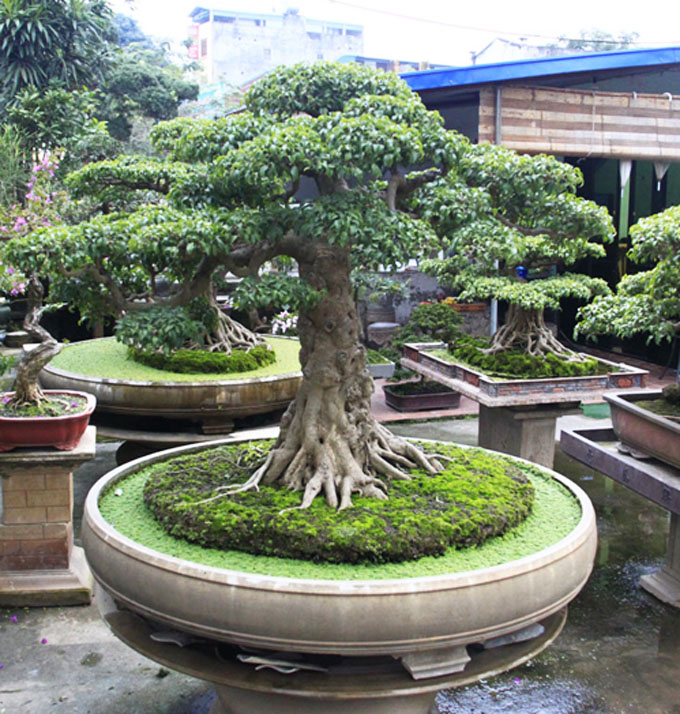 We know this tree is very large, but exactly how large is difficult to tell (the uncropped photo immediately below might help a bit). In addition to its great size, it shows an excellent base and nebari, as well as some gnarly bumps that look a bit like melting wax. I think I can say with confidence that it’s Ficus. All the photos in this post were taken by Robert Steven on a recent trip to Vietnam.
We know this tree is very large, but exactly how large is difficult to tell (the uncropped photo immediately below might help a bit). In addition to its great size, it shows an excellent base and nebari, as well as some gnarly bumps that look a bit like melting wax. I think I can say with confidence that it’s Ficus. All the photos in this post were taken by Robert Steven on a recent trip to Vietnam.
Robert Steven seems to teach and travel almost incessantly, and yet he still finds time to write about bonsai, run Bonsai Aesthetics (his bonsai business) and of course, to work on his own trees. He also is one of the most responsive email communicators I’ve ever known and seems to have a nearly infinite number of students and friends that I imagine he also communicates with… which begs the question; when does he sleep?
Anyway, based on something Robert wrote in the comments of a previous post (in response to another comment), I decided to do a post on bonsai Vietnam. As I was just starting to search for photos, I received an email from Robert about an unrelated piece of business. When I responded, I asked him if he had any photos of Vietnamese bonsai, and presto, here they are.
So, sticking with the Vietnam via Robert theme, here is what he has to say about bonsai in Vietnam (from the aforementioned comments on a previous post): “I have been traveling frequently to Vietnam recently for lectures and demo. Vietnamese bonsai is progressing extremely fast during the last few years in parallel with the growth of economic and living standard.
The interest in bonsai in Vietnam is amazing and unbelievable. I travel from the south of Ho Chi Min City to the north of Hanoi, from the remote villages to the cities, every house with terrace (when I say every house, I mean ALMOST every house) always has bonsai.
The styles in the south and the north are totally different. The south (around HCM city) likes the landscape..specifically the water and land penjing and other deciduous species e.g. Wrightia and they don’t like ficus. In the contrary, in the north, they like BIG bonsai, specifically ficus.
They have their own style of ficus with wild aerial roots with unique pots. In few years, Vietnam will certainly be on the world bonsai map with the ficus as their icon..they still need some times to improve their technique in forming ideal ramification.
Another amazing thing is their involvement in the internet because they are mostly young people. They have an internet forum similar to IBC..and you won’t believe that there are always few thousands members online each day. If they didn’t have the language barrier, I believe IBC forum will be dominated by Vietnamese members.
I receive dozens of friend requests from Vietnam each day although they don’t speak English, otherwise…”
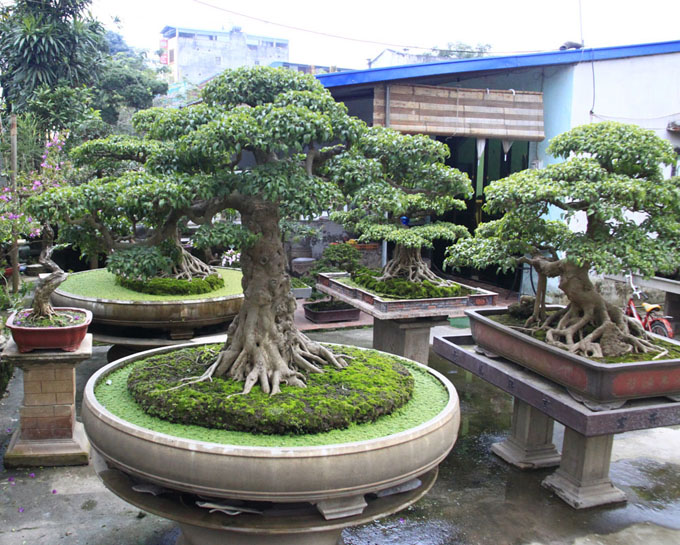 The king and his court (the queen and her court?). This uncropped version of the photo above offers a little more perspective.
The king and his court (the queen and her court?). This uncropped version of the photo above offers a little more perspective.
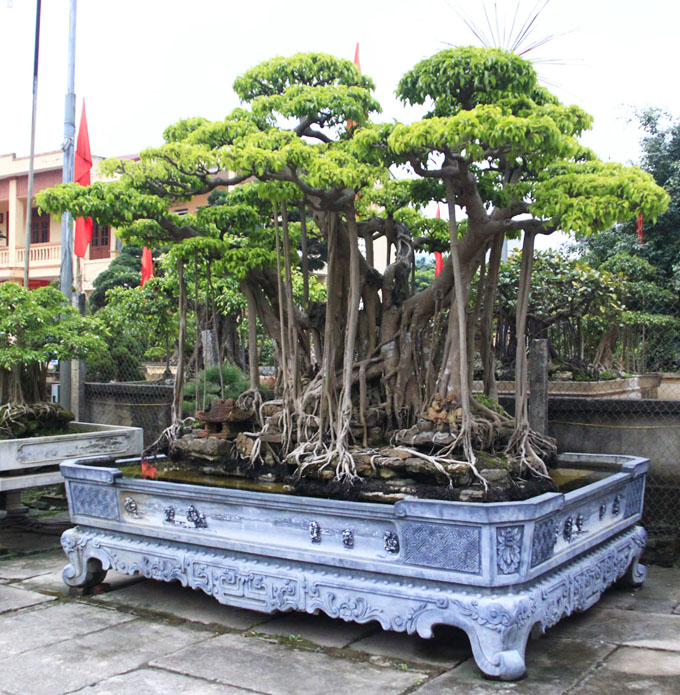 Can you imagine owning a tree like this (or even pot like this for that matter)? If you could get your hands on something like this, you’d have to have a greenhouse or a large sun room (unless you live in the tropics). BTW, you might notice that the tree appears to be surrounded by a moat of water, which means it’s growing in almost no soil. You might also notice that it has a couple little people perched on a stone (there’s a building on the other side too). And then you might take a step back and notice just how spectacular and just how huge this remarkable planting is.
Can you imagine owning a tree like this (or even pot like this for that matter)? If you could get your hands on something like this, you’d have to have a greenhouse or a large sun room (unless you live in the tropics). BTW, you might notice that the tree appears to be surrounded by a moat of water, which means it’s growing in almost no soil. You might also notice that it has a couple little people perched on a stone (there’s a building on the other side too). And then you might take a step back and notice just how spectacular and just how huge this remarkable planting is.
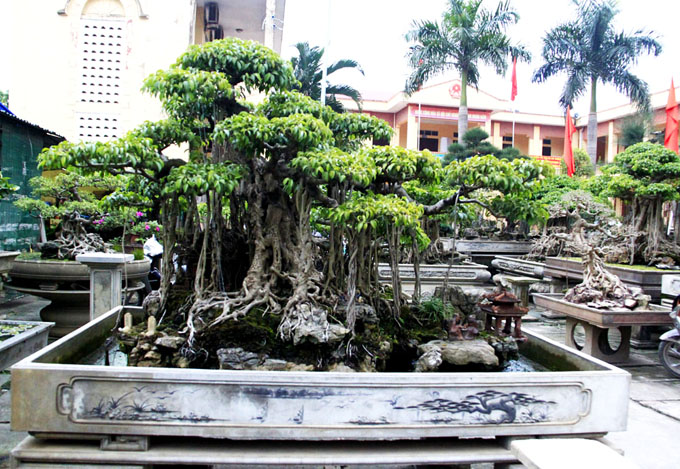 Here’s another one with a moat. The moat’s little empty now, but never mind, both the tree and pot are still spectacular.
Here’s another one with a moat. The moat’s little empty now, but never mind, both the tree and pot are still spectacular.
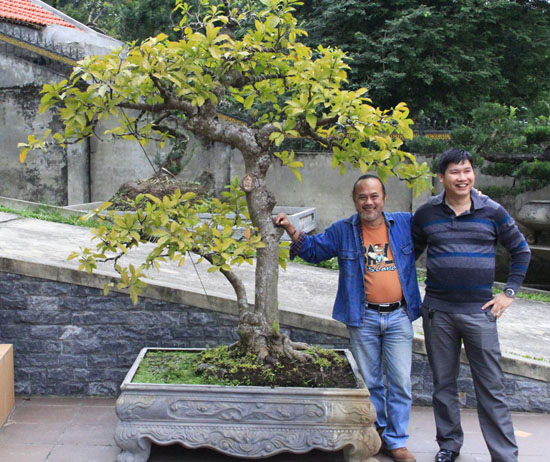 A little perspective doesn’t hurt. That’s Robert wedged between a very large bonsai and a Vietnamese friend.
A little perspective doesn’t hurt. That’s Robert wedged between a very large bonsai and a Vietnamese friend.
The pot looks big enough to be a bed. How do they engineer a pot that large? Would like to see that pottery and talk to the potter.
Hi Wayne,
Thanks for the nice words, as usual..haha..
I sleep 4 hours a day, and thanks to the “Qi” I am practicing (another invisible thing from China, but real…).
These are the photos from the north, the water-and-land penjing photos I sent you were from the south. These bonsai belong to one of the local collectors in Halong Bay area, and there are dozens of bigger collectors with simply few hundreds big bonsai in their big garden (they are mostly living in a bungalow type house with huge garden with bonsai). Almost none of their bonsai can be carried by hands…
Connie,
Those pots are made of cement, but they look like stone-carved with the ornaments. They like to plant their large ficus with water around, very few soil indeed.
I am expecting somedays to see the better ramification forms, then they will have the BEST ficus bonsai in the world ! I dare to say will be better than the ficus style from Taiwan..much more natural look as ficus trees in nature, despite the size is rather too big…
I wish I had a TERRACE of the size of those pots ;-)
Very impressive trees indeed, but is there another name for this style seeing as most appear to be well over the traditionally accepted height of what is currently considered bonsai? Love the moats!
Thanks for the article. I hope so like that, its so wonderfull and how beautiful if our environment if the plant (either in the pot or not) be a good landscape look like a bonsai
Hi BC,
I have seen and heard some people mention a size limit for bonsai, but then I’ve seen trees 3 meters (about 10 feet) tall (or even taller) in huge wooden (or other material) pots, referred to as bonsai.
What Robert just said in his comment… “despite the size is rather too big…” though a little vague, gives you some clue to his thinking on the matter.
I just looked up bonsai in Wikipedia and they list Imperial bonsai as 60-80 inches (152 – 203 cm) as the largest size. Still, that’s just Wikipedia, so I’d say, your guess is as good (or better) than mine.
Yes, Wayne.
In many countries, the limit is 80cm, some 100cm. In China, they changed to 120 cm and I was told that they would like to increase to 150cm which created debates on that.
The countries that like big bonsai are China (getting bigger and bigger), Vietnam and Thailand.
In my personal opinion, over 100 cm is too big and may just suit for garden decoration.
Thanks Robert, it’s an interesting topic.
I guess if you took the literal translation of ‘tree in a pot’ (planting in a pot) then almost anything can pass.
Also, if you consider that there is no single international agency that sets standards for bonsai, then there will always be divergent views on what exactly is a bonsai.
Wayne,
I am sure it’s simply a process in these region. In the beginning, there are always kind of competition among the rich collectors to have bigger and more expensive bonsai (for prestige reason), and they have places for that. But when land is getting more and more expensive, more medium-level new comers from big cities where places can be a problem for big bonsai, then they will be getting to smaller size bonsai.
some of the trees in the first photo look like there is a light green margin around the main soil “clump” where the tree is planted – is this a style, a personal preference or a little moat covered with duck weed?
Hi Nikki,
My guess is you are talking about the big Ficus in the round pot. Robert probably knows. My guess is white stones covered with algae, but that’s just a wild guess and my guesses are often, if not usually, wrong.
Hi Wayne
thanks for the words and the photos. I am looking for a company in Vietnam selling and sending these big, flat pots to Denmark. Do you know some?
Best regards
Jens, Copenhagen
Hi jens,
Sorry, but I don’t of any companies in Vietnam, let alone ones that ship.
Robert Steven has some contacts in Vietnam, he might be able to help.
Nikki, they like to plant their ficus with water around, like growing on a small island.
Jens, I don’t have the contact who make this pot.
Hi guys,
Thanks Robert, it’s very interesting topic.
In Vietnam the large tree in the large pot as you seen from the third photo down they called
Cay Kieng) means tree and landscape or decorate tree in garden which were the Vietnamese’s
traditional bonsai for nearly a thousand years I would said. Any bonsai that short (small size) are influence by Japan or China.
Hi jens,
(Bonsai Thanh Tam) in Saigon south of Vietnam is a company will shipping worldwide.